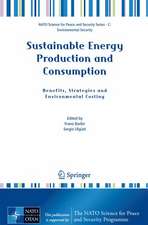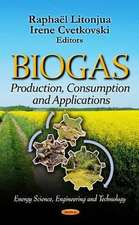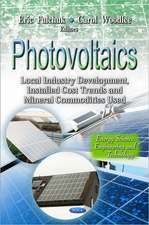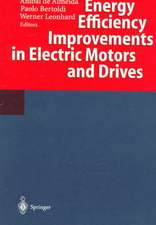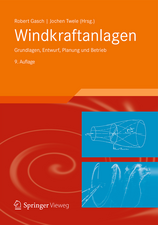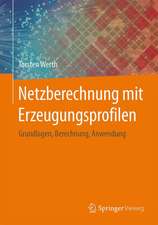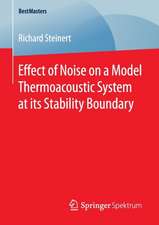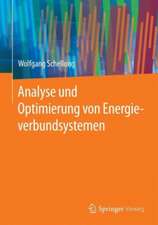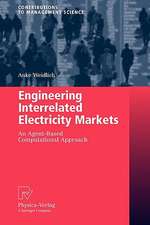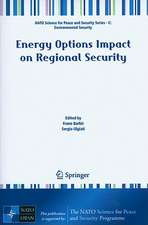Energy Efficiency in Domestic Appliances and Lighting: Proceedings of the 10th International Conference (EEDAL'19): Springer Proceedings in Energy
Editat de Paolo Bertoldien Limba Engleză Hardback – 19 mai 2022
Energy efficiency helps to mitigate CO2 emissions and at the same time increases the security of energy supply. Energy efficiency is recognized as the cleanest, quickest and cheapest energy source. Not only this, but energy efficiency brings several additional benefits for society and end-users, such as lower energy costs, reduced local pollution, better outdoor and indoor air quality, etc.
However, in some sectors, such as the residential sector, barriers to investments in energy efficiency remain. Legislation adopted in several jurisdictions (EU, Japan, USA, China, India, Australia, Brazil, etc.) helps in removing barriers and fosters investments in energy efficiency. These initiatives complement innovative financing schemes for energy efficiency, the provision of energy services by energy service companies and different types of information programs. At the same time, progress in appliance technologies and in solid state lighting offer high levels of efficiency. LED lighting is an example.
As with previous conferences in this series, EEDAL’19 provided a unique forum to discuss and debate the latest developments in energy and environmental impact of households, including appliances, lighting, heating and cooling equipment, electronics, smart meters, consumer behavior, and policies and programs. EEDAL addressed non-technical issues such as consumer behavior, energy access in developing countries, and demand response.
| Toate formatele și edițiile | Preț | Express |
|---|---|---|
| Paperback (1) | 736.64 lei 6-8 săpt. | |
| Springer International Publishing – 20 mai 2023 | 736.64 lei 6-8 săpt. | |
| Hardback (1) | 1015.23 lei 6-8 săpt. | |
| Springer International Publishing – 19 mai 2022 | 1015.23 lei 6-8 săpt. |
Din seria Springer Proceedings in Energy
- 18%
 Preț: 1389.30 lei
Preț: 1389.30 lei - 18%
 Preț: 1237.80 lei
Preț: 1237.80 lei - 18%
 Preț: 1388.53 lei
Preț: 1388.53 lei - 24%
 Preț: 821.94 lei
Preț: 821.94 lei - 18%
 Preț: 1895.99 lei
Preț: 1895.99 lei - 18%
 Preț: 1109.16 lei
Preț: 1109.16 lei - 24%
 Preț: 1108.17 lei
Preț: 1108.17 lei - 18%
 Preț: 1386.92 lei
Preț: 1386.92 lei - 18%
 Preț: 1592.92 lei
Preț: 1592.92 lei - 18%
 Preț: 2126.60 lei
Preț: 2126.60 lei - 24%
 Preț: 1126.84 lei
Preț: 1126.84 lei - 18%
 Preț: 1265.39 lei
Preț: 1265.39 lei - 18%
 Preț: 738.06 lei
Preț: 738.06 lei -
 Preț: 420.97 lei
Preț: 420.97 lei - 18%
 Preț: 1111.22 lei
Preț: 1111.22 lei - 18%
 Preț: 1224.18 lei
Preț: 1224.18 lei - 18%
 Preț: 1409.03 lei
Preț: 1409.03 lei - 18%
 Preț: 1224.68 lei
Preț: 1224.68 lei - 18%
 Preț: 948.79 lei
Preț: 948.79 lei - 15%
 Preț: 638.57 lei
Preț: 638.57 lei - 18%
 Preț: 952.40 lei
Preț: 952.40 lei - 18%
 Preț: 1239.37 lei
Preț: 1239.37 lei - 18%
 Preț: 1848.33 lei
Preț: 1848.33 lei - 18%
 Preț: 1018.55 lei
Preț: 1018.55 lei - 18%
 Preț: 1378.59 lei
Preț: 1378.59 lei - 18%
 Preț: 1106.12 lei
Preț: 1106.12 lei - 18%
 Preț: 962.18 lei
Preț: 962.18 lei - 18%
 Preț: 1230.84 lei
Preț: 1230.84 lei -
 Preț: 428.68 lei
Preț: 428.68 lei - 15%
 Preț: 641.53 lei
Preț: 641.53 lei - 18%
 Preț: 1115.14 lei
Preț: 1115.14 lei - 18%
 Preț: 1230.35 lei
Preț: 1230.35 lei - 24%
 Preț: 1041.84 lei
Preț: 1041.84 lei - 18%
 Preț: 947.98 lei
Preț: 947.98 lei - 24%
 Preț: 784.30 lei
Preț: 784.30 lei - 18%
 Preț: 948.61 lei
Preț: 948.61 lei - 18%
 Preț: 1243.60 lei
Preț: 1243.60 lei - 18%
 Preț: 1244.59 lei
Preț: 1244.59 lei - 24%
 Preț: 786.47 lei
Preț: 786.47 lei
Preț: 1015.23 lei
Preț vechi: 1238.10 lei
-18% Nou
Puncte Express: 1523
Preț estimativ în valută:
194.26€ • 202.82$ • 160.78£
194.26€ • 202.82$ • 160.78£
Carte tipărită la comandă
Livrare economică 05-19 aprilie
Preluare comenzi: 021 569.72.76
Specificații
ISBN-13: 9783030791230
ISBN-10: 3030791238
Pagini: 498
Ilustrații: VII, 498 p. 177 illus.
Dimensiuni: 155 x 235 mm
Greutate: 0.89 kg
Ediția:1st ed. 2022
Editura: Springer International Publishing
Colecția Springer
Seria Springer Proceedings in Energy
Locul publicării:Cham, Switzerland
ISBN-10: 3030791238
Pagini: 498
Ilustrații: VII, 498 p. 177 illus.
Dimensiuni: 155 x 235 mm
Greutate: 0.89 kg
Ediția:1st ed. 2022
Editura: Springer International Publishing
Colecția Springer
Seria Springer Proceedings in Energy
Locul publicării:Cham, Switzerland
Cuprins
Chapter 1. Energy savings 2021: New European Energy Label and Ecodesign Requirements for Washing Machines.- Chapter 2. Towards consumer relevant product testing.- Chapter 3. Developing a Lighting Infographic Label for South African Household Consumers.- Chapter 4. Decomposition Analysis of National CO2 Emissions Inventory in the Residential and Commercial Sectors in Japan - Effects of Energy Efficiency Improvement and Behavior Change.- Chapter 5. Little Appliances with Big Power Appetites.- Chapter 6. What can market surveillance learn from reducing violent crime in Chicago?.- Chapter 7. Residential End-Use energy consumption and appliance ownership patterns in India.- Chapter 8. Environmental Impact on Energy Efficiency of Room Air Conditioners in India.- Chapter 9. Policy measures and impact on the market for the Room Air Conditioners in India.- Chapter 10. When the Party’s Over, Don’t Turn off the Lights! - Making Donor Funded S&L Programs Sustainable.- Chapter 11. Latest technologydevelopments in domestic appliances and their implications on household energy use and the designing and implementation of policies and programmes in developing countries.- Chapter 12. Transforming Air Conditioner Markets Through Effective Labeling Programs: Case Studies from India, Europe, Brazil, Thailand, and Vietnam.- Chapter 13. Final impact assessment of a small-scale biomass gasifier fuel-cell CHP system for clean on-site power generation.- Chapter 14. Mainstreaming Energy Productivity Lending Practices among Financial Institutions (FIs).- Chapter 15. The effectiveness of gas-boosted solar water heaters in an Australian monitored low-energy housing development.- Chapter 16. Modelling Residential End-Use Electricity Consumption Using Statistical and Artificial Intelligence Approaches.- Chapter 17. Going Digital! South Africa’s new Online Appliance Registration Database to Incorporate QR Code Functionality and Smart Phone APP.- Chapter 18. Aligning Chinese LED lighting standardswith international best practices.- Chapter 19. Field and Laboratory Tests of an Efficient Fan Controller with Advanced Fault Detection Diagnostics for Residential Cooling and Heating Systems.- Chapter 20. Energy consumption scenarios and policy implications for home automation and IoT.- Chapter 21. Consumer demand side flexibility in Europe.- Chapter 22. The Stromspar-Check: A success story for a social energy transition.- Chapter 23. Using Feedback on Computer States to Improve Power Management Behaviors.- Chapter 24. The Energy Impacts of Video Streaming Devices and Smart Speakers.- Chapter 25. Impact of new approaches to address energy management gaps on total energy use in computer workstations.- Chapter 26. Regulating on- and off-grid lighting and appliances in Eastern and Southern Africa.- Chapter 27. Policy measures to prevent dumping of environmentally harmful and low efficiency cooling appliances in African countries: Kenya as a case study.- Chapter 28. Experiences of Electric pressure cookers in East Africa.- Chapter 29. Intermittence Plus » project open new paths for increasing flexibility of the electrical networks.- Chapter 30. Appliance Efficiency in Pacific Island Countries.- Chapter 31. A Better Way: Voluntary Agreements to Move Markets and Accelerate Savings.- Chapter 32. A Business Model Framework for New Small and Medium-Sized Enterprise Energy Service Provision Companies in China.
Notă biografică
Paolo Bertoldi is a senior expert in sustainable energy, climate change and energy efficiency at the European Commission. Some of his key areas of expertise include: Energy Service Companies (ESCOs), market based instruments, multilevel governance, environmental leadership, ICT energy consumption. He is an experienced Editor In Chief. Bertoldi is also skilled in sustainable energy, corporate social responsibility, climate change polices, and data centre, and is in charge of policy analysis for energy efficiency at the European Commission where he has served as Energy Efficiency Expert and Senior Expert for a total of 28 years. He is also a Laed Author for IPCC Reports. He has an engineering degree focused in energy systems and electrical system from University of Padova, Italy
Textul de pe ultima copertă
This book contains peer-reviewed papers presented at the 10th International Conference on Energy Efficiency in Domestic Appliances and Lighting (EEDAL'19), held in Jinan, China from 6-8 November 2019.
Energy efficiency helps to mitigate CO2 emissions and at the same time increases the security of energy supply. Energy efficiency is recognized as the cleanest, quickest and cheapest energy source. Not only this, but energy efficiency brings several additional benefits for society and end-users, such as lower energy costs, reduced local pollution, better outdoor and indoor air quality, etc.
However, in some sectors, such as the residential sector, barriers to investments in energy efficiency remain. Legislation adopted in several jurisdictions (EU, Japan, USA, China, India, Australia, Brazil, etc.) helps in removing barriers and fosters investments in energy efficiency. These initiatives complement innovative financing schemes for energy efficiency, the provision of energy services by energy service companies and different types of information programs. At the same time, progress in appliance technologies and in solid state lighting offer high levels of efficiency. LED lighting is an example.
As with previous conferences in this series, EEDAL’19 provided a unique forum to discuss and debate the latest developments in energy and environmental impact of households, including appliances, lighting, heating and cooling equipment, electronics, smart meters, consumer behavior, and policies and programs. EEDAL addressed non-technical issues such as consumer behavior, energy access in developing countries, and demand response.
Energy efficiency helps to mitigate CO2 emissions and at the same time increases the security of energy supply. Energy efficiency is recognized as the cleanest, quickest and cheapest energy source. Not only this, but energy efficiency brings several additional benefits for society and end-users, such as lower energy costs, reduced local pollution, better outdoor and indoor air quality, etc.
However, in some sectors, such as the residential sector, barriers to investments in energy efficiency remain. Legislation adopted in several jurisdictions (EU, Japan, USA, China, India, Australia, Brazil, etc.) helps in removing barriers and fosters investments in energy efficiency. These initiatives complement innovative financing schemes for energy efficiency, the provision of energy services by energy service companies and different types of information programs. At the same time, progress in appliance technologies and in solid state lighting offer high levels of efficiency. LED lighting is an example.
As with previous conferences in this series, EEDAL’19 provided a unique forum to discuss and debate the latest developments in energy and environmental impact of households, including appliances, lighting, heating and cooling equipment, electronics, smart meters, consumer behavior, and policies and programs. EEDAL addressed non-technical issues such as consumer behavior, energy access in developing countries, and demand response.
Caracteristici
Provides global coverage of recent policies and programs for improving energy efficiency in the residential sector Covers the latest advances in domestic appliances and lighting technologies Addresses the residential sector’s contribution to limiting climate change

